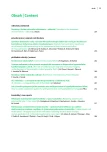How to create cooperative patient for antihypertensive and hypolipidemic therapy
Authors:
Jan Piťha 1,2
Authors‘ workplace:
Interní klinika 2. LF UK a FN Motol, Praha
1; Centrum experimentální medicíny IKEM, Praha
2
Published in:
Vnitř Lék 2017; 63(4): 272-276
Category:
Reviews
Overview
Patient drug adherence is a major problem especially in the prevention of cardiovascular disease of atherosclerotic origin. On one hand, antihypertensive drugs and hypolipidemic drugs/statins are among the most successful, ones the other hand, they are among the drugs which are most frequently skipped by the patients. Improvement could be realized by education of patients, more frequent follow-ups, as well as by the use of new technologies involving specific dispensers and other, even more sophisticated methods. Nevertheless, among the most successful strategies is the simplification of medication, particularly the use of drugs with a longer half-life and the use of combination of several drugs in a single tablet. Therefore, we have quite wide range of options to improve patient compliance. However, some disadvantages should be kept in mind associated with these techniques. The aim of this article is to discuss potential problems and solutions associated with patient adherence/compliance with respect to antihypertensive and hypolipidemic treatment with an emphasis on practical approach.
Key words:
drug adherence – dyslipidemia – hypertension – pharmacotherapy
Sources
1. ADHERENCE TO LONG-TERM THERAPIES. Evidence for action. World Health Organization: 2003. ISBN 92 4 154599 2. Dostupné z WWW: <http://www.who.int/chp/knowledge/publications/adherence_full_report.pdf>.
2. Epstein RS. Medication adherence: hope for improvement? Mayo Clin Proc 2011; 86(4): 268–270. <http://dx.doi.org/10.4065/mcp.2011.0123>.
3. Zdravotnická ročenka České republiky. Dostupné z WWW:<http://www.uzis.cz/katalog/rocenky/zdravotnicka-rocenka-ceske-republiky>.
4. Chytil L, Strauch B, Cvačka J et al. Determination of doxazosin and verapamil in human serum by fast LC-MS/MS: application to document non-compliance of patients. Chromatogr B Analyt Technol Biomed Life Sci 2010; 878(30): 3167–3173. Dostupné z DOI: <http://dx.doi.org/10.1016/j.jchromb.2010.09.032>.
5. Strauch B, Petrák O, Zelinka T et al. Precise assessment of noncompliance with the antihypertensive therapy in patients with resistant hypertension using toxicological serum analysis. J Hypertens 2013; 31(12): 2455–2461.
6. Ceral J, Habrdova V, Vorisek V et al. Difficult-to-control arterial hypertension or uncooperative patients? The assessment of serum antihypertensive drug levels to differentiate non-responsiveness from non-adherence to recommended therapy. Hypertens Res 2011; 34(1): 87–90.
7. Kallem RR, Karthik A, Chakradhar L et al. Development and validation of a highly sensitive and robust LC-MS/MS with electrospray ionization method for quantification of rosuvastatin in small volume human plasma samples and its application to a clinical study. Arzneimittelforschung 2007; 57(11): 705–711. Dostupné z DOI: <http://dx.doi.org/10.1055/s-0031–1296671>.
8. Waldron J, Webster C. Liquid chromatography-tandem mass spectrometry method for the measurement of serum mevalonic acid: a novel marker of hydroxymethylglutaryl coenzyme A reductase inhibition by statins. Ann Clin Biochem 2011; 48(Pt 3): 223–232. Dostupné z DOI: <http://dx.doi.org/10.1258/acb.2010.010182>.
9. Bramlage P, Sims H, Minguet J et al. The polypill: An effective approach to increasing adherence and reducing cardiovascular event risk. Eur J Prev Cardiol 2017; 24(3): 297–310. Dostupné z DOI: <http://dx.doi.org/10.1177/2047487316674817>.
10. Papageorgiou N, Zacharia E, Briasoulis A et al. Statins and myocardial infarction: Type, dose, and administration time: Does it matter? Trends Cardiovasc Med 2016; 26(5): 433–441. <http://dx.doi.org/10.1016/j.tcm.2016.01.001>.
11. Elis A, Lishner M. Non-every day statin administration--a literature review. Eur J Intern Med 2012; 23(5): 474–478. Dostupné z DOI: <http://dx.doi.org/10.1016/j.ejim.2012.02.006>.
12. Marcus FI, Baumgarten AJ, Fritz WL et al. Alternate-day dosing with statins. Am J Med 2013; 126(2): 99–104. Dostupné z DOI: <http://dx.doi.org/10.1016/j.amjmed.2012.08.007>.
13. Kim YS, Sunwoo S, Lee HR et al. Korea Post-Marketing Surveillance Research Group. Determinants of non-compliance with lipid-lowering therapy in hyperlipidemic patients. Pharmacoepidemiol Drug Saf 2002; 11(7): 593–600.
14. Projekt intenzivního ovlivnění dyslipidémií u pacientů s ischemickou chorobou dolních končetin. Practicus 2016; 10: 9–11. Dostupné z DOI: <http://dx.doi.org/http://web.practicus.eu/sites/cz/Documents/Practicus-2016–10/09-ICHDK.pdf>.
Labels
Diabetology Endocrinology Internal medicineArticle was published in
Internal Medicine

2017 Issue 4
Most read in this issue
- Relapsing autoimmune pancreatitis type 1: case report
- Controversies around QALYs
- Novelties in the treatment of heart failure
- AT1 blockers – comparability with ACE inhibitors
